#Tundra shrew
Text

8 notes
·
View notes
Text
Mammals of the March of Maedhros
Fish, Birds, Flowers
Flora, fauna, geography and environment Masterlist
Other world building in the Himring tag!
The March of Maedhros was a cold realm in Northeastern Beleriand. It was located slightly Southeast of Dorthonion and south of the planes and meadowlands of Lothlann and Ard Galen. The March was a cold region with taiga forested hills and icy waters, including the sources of several rivers, namely Celon and Little Gelion which were located in the other Hills around Himring.
The March falls between the cold mountains on the Southern and Eastern borders of Dorthonion and the mountainous regions of the Gap and Thargelion on its own Eastern border.
Like my other posts of this kind I will include more world building notes at the end (relationship between people/elves and the fauna, symbology or significance of certain species in local cultures, etc), otherwise this would just be a long list of species. Please always feel free to ask more about this, it’s one of my favorite topics 
Taiga and tundra: musk deer: reindeer, red squirrel, tundra wolf, altai mole, brown bear, snow vole, taiga shrew
Other forest: forest dormouse, northern birch mouse, pine marten, sable, common shrew, northern pika, moose, lynx
Hills and alpine meadow: grey marmot, forest steppe marmot, long tailed ground squirrel, wild horse, beech marten, northern badger
Northern reaches: snow leopard, wild yak, snow sheep
Throughout: red fox, brown hare, Eastern roe deer, field mouse
World building notes:
-As it’s probably obvious by the art in my background, the idea of snow leopards in the March is very important to me! Some of the most skilled among Maedhros’s captains hunted and scouted along side them and their image came to represent the ruthless, efficient and precise nature of his fighters in art and heraldry 
-I also believe that they were wild otters in the rivers specifically northern Celon,the colder one, rather unique to the region. These were far larger than common otters and well adapted to the cold. 
-Horses were brought in large numbers, including the descendants of Valinor horses. In the March they are bred for endurance, and ability to withstand the cold and train to respond to almost entirely non-verbal commands, especially by some sections of the scouts who ride them
-I always imagine a location or locations similar to Lake Baikal in Siberia, which is home the world’s only completely freshwater seal as well as cnidarian species that are not found anywhere else in the world. The seals in thr near frozen lake are abundant but are rarely slain. They are near inedible though their fat is highly useful for oils and their skins are occasionally used as well. The lake is located north of Himring and was originally the result of geologic activity in the Ered Engrin.
-Reindeer are kept by some of the Noldor and their allies in the more remote regions of the march. Their fur, skin, meat, and milk are all used.
-Pine martens and sables are dear to the Avarin groups of northeast Beleriand, some members even taking them as companions or scouts. They represent will and joy in stories and art
-I like to imagine smaller species of mammoths or woolly rhinos trek through the March on their search for fresh grass and vegetation.
As always please feel free to ask more, I really love world building and I always feel these posts are incomplete
37 notes
·
View notes
Text
OH MY GOD!!!!!!!!!!!!!! ICE FLOW, NO WHERE TO GO! ICE FLOW, NO WHERE TO GO! LOST IN THE BLINDING WHITENESS OF THE TUNDRAAAA! CHECK HIM OUT! THEY CALL HIM THE SHREW! ARMS IN SHORT, IN WITH THE CLAW! I'M LITTLE JOHNNY FROSTBITE MOVING AROUND FREEZING YOU UP - FREEZING YOU DOWN LIKE AN ICICLE! COMING IN YOUR TENT IN THE PINK LIGHT SCISSOR BITE! ARCTIC DEATH!! INFINITE NIGHT!!! CALL ME TUNDRA BOY BECAUSE I MOVE LIKE AN ARCTIC L I Z A R D ! WHEN THE BLIZZARD STRIKES I DISAPPEAR LIKE A PIPE DREAM ALL THAT'S LEFT IS A GLEAM!!! ON A TENT PEG BOOSH! BOOSH! STRONGER THAN A MOOSE! DON'T LOCK YOUR DOOR OR WE'LL COME THROUGH YOUR ROOFTOP! STOP, LOOK ROUND, TAKE YOUR MIND OFF THE FLOOR! CAUSE THE BOOSH IS LOOSE AND WE'RE A LITTLE BIT R A W ! ICE FLOW, NO WHERE TO GO! ICE FLOW, NO WHERE TO GO! LOST IN THE BLINDING WHITENESS OF THE TUNDRAAAAA! AWOOOOO!!!!!
14 notes
·
View notes
Text


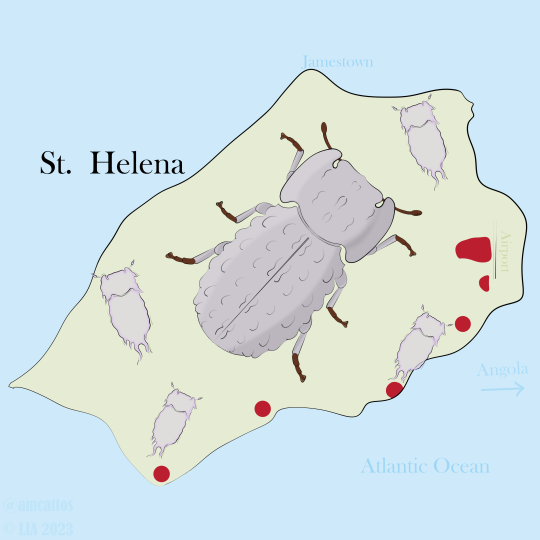
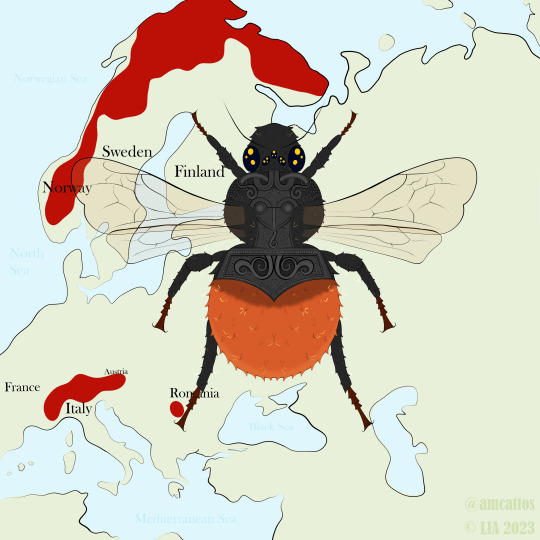
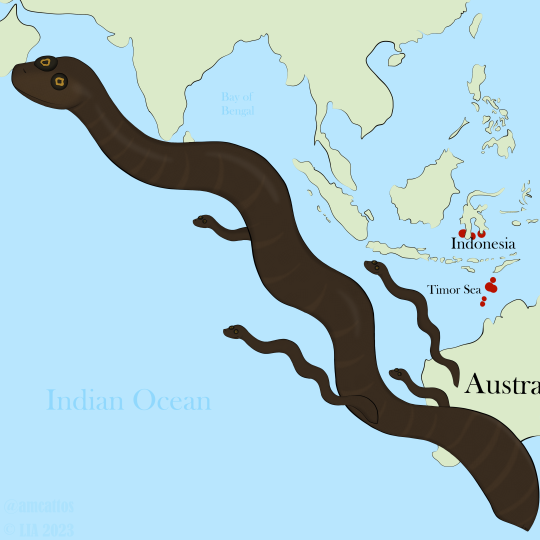
© LIA 2023
Vulnerable Animals Week 2023
My submissions to last year's #vulnerableanimalsweek2023:
Day 1 (Tundra): Pribilof Island Shrew (Sorex pribilofensis)
Day 2 (Wetlands): Laos Warty Newt (Laotriton laoensis)
Day 3 (Desert): Leleup's Darkling Beetle (Tarphiophasis leleupi)
Day 4 (Alpine): Alpine Bumblebee (Bombus alpinus)
Day 5 (Ocean): Dusky Sea Snake (Aipysurus fuscus)
#catto#illustration#entomology#digitalillustration#digital illustration#digital art#endangered species#vulnerable animals#bee#bumble bee#sea snake#shrew#wildlife conservation#conservation#beetle#insects#newt#art event#art
3 notes
·
View notes
Text
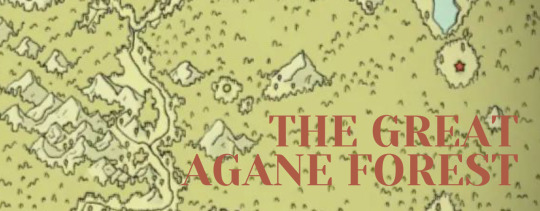
ii. THE GREAT AGANE FOREST

The central continent in the world of Sedo is known for its three [3] major geographical regions; the Desert, the Arctic, and the biggest forest area in all of the world, the great Agane forest. The other two will be relevant further down the line, so let's discuss the settings of the current area; the great Agane forest, a vast expanse of mountain ranges and dense woodland that spans the length and breadth of the central continent, stretching from the scorching Northern Deserts of the Mitherosan Empire to the cold Southern divide of the Afridecian Empire and the Killen Territories.
The forest is so vast that it has the tundra, the mountains, the forest, and the savanna biomes, all teeming with a wide range of wildlife, drawn from the diverse landscapes that make up its borders, from small insects like butterflies and dragonflies to large predators like lynx and bears. You might see deer grazing in a clearing, or hear the haunting call of a loon on a nearby lake. Birds like the Gonthar’yan bush warbler or the great spotted woodpecker flit through the air, while small mammals like shrews and squirrels scurry along the forest floor.
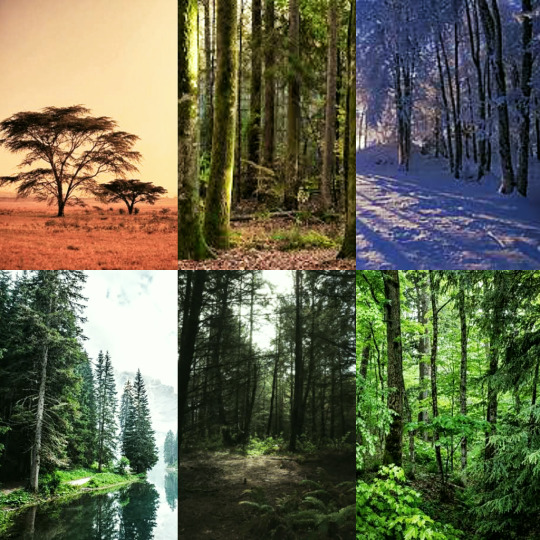
Forest Inspirations
Surrounded by towering mountains and mountain ranges. These majestic peaks are often shrouded in mist and clouds, creating an ethereal and mysterious atmosphere. The mountain ranges are home to a variety of creatures, from the nimble mountain goat to the elusive snow leopard. You might catch a glimpse of a soaring eagle or hear the haunting call of a wolf echoing across the valleys.

note that this map has Killen in the North
The mountain ranges are also a source of natural resources for the inhabitants of the surrounding areas. Precious metals like gold and silver can be found in the rocks and streams, while the forests and meadows provide wood, herbs, and other resources.
Amidst the landscape, a mixture of shrubs and grass weave together to create a tapestry of life on the forest floor, providing nourishment and shelter for the inhabitants of the forest. Towering trees of deciduous and evergreen trees rise high into the sky, their branches reaching out to the heavens, providing shade and protection to those who seek it. In the south, where the land is cold and Arctic, the trees stand tall and hardy, while in the north, the forest gives way to rainforest and savannah, a testament to the diversity of life that can be found within the great Agane Forest.
As you explore deeper into the forest, you might come across a babbling brook or a hidden glade, where shafts of sunlight pierce the canopy overhead. The forest of Agane is a place of beauty and wonder, where every turn can reveal a new and unexpected discovery.
0 notes
Text
Which animals can best withstand climate change?
https://sciencespies.com/nature/which-animals-can-best-withstand-climate-change/
Which animals can best withstand climate change?
Extreme weather such as prolonged drought and heavy rainfall is becoming more and more common as the global average temperature rises — and it will only get worse in the coming decades. How will the planet’s ecosystems respond?
“That is the big question and the background for our study,” said biologist John Jackson, who, together with his biologist colleagues Christie Le Coeur from the University of Oslo and Owen Jones from University of Southern Denmark, authored a new study, published in eLife.
John Jackson is now at Oxford University but was at the University of Southern Denmark when the study was made. Owen Jones is associate professor at the Department of Biology, University of Southern Denmark.
Llama, moose and elephant
In the study, the authors analyzed data on population fluctuations from 157 mammal species from around the world and compared them with weather and climate data from the time the animal data were collected. For each species there are 10 or more years of data.
Their analysis has given them an insight into how populations of animal species have coped at times of extreme weather: Did they become more, or less, numerous? Did they have more or fewer offspring?
advertisement
“We can see a clear pattern: Animals that live a long time and have few offspring are less vulnerable when extreme weather hits than animals that live for a short time and have many offspring. Examples are llamas, long-lived bats and elephants versus mice, possums and rare marsupials such as the woylie,” said Owen Jones.
Less affected by extreme weather:
African elephant, Siberian tiger, chimpanzee, greater horseshoe bat, llama, vicuña, white rhinoceros, grizzly bear, American bison, klipspringer, Schreibers’s bat.
More affected by extreme weather:
Azara’s grass mouse, olive grass mouse, elegant fat-tailed mouse opossum, Canadian lemming, Tundra vole, Arctic fox, stoat, common shrew, woylie, arctic ground squirrel.
advertisement
Quick drop — but also quick boom
Large, long-lived animals are better able to cope with conditions like prolonged drought; their ability to survive, to reproduce and to raise their offspring is not affected to the same extent as small, short lived animals. They can, for example, invest their energy into one offspring, or simply wait for better times when conditions become challenging.
On the other hand, small short-lived rodents have more extreme population changes in the short term. In the event of a prolonged drought, for example, large parts of their food base may disappear more rapidly: insects, flowers, fruits, and they are left to starve because they have limited fat reserves.
The populations of these small mammals may also boom to take advantage when conditions improve because, in contrast to large mammals, they can produce many offspring.
Not the same as risk of extinction
“These small mammals react quickly to extreme weather, and it goes both ways. Their vulnerability to extreme weather should therefore not be equated with a risk of extinction,” said John Jackson.
He also reminds us that the ability of an animal species to withstand climate change must not stand alone when assessing the species’ vulnerability to extinction:
“Habitat destruction, poaching, pollution and invasive species are factors that threaten many animal species — in many cases even more than climate change,” he emphasized.
The animals we don’t know much about
The researchers’ study not only gives an insight into how these specific 157 mammal species react to climate changes here and now. The study can also contribute to a better general understanding of how the planet’s animals will respond to ongoing climate change.
“We expect climate change to bring more extreme weather in the future. Animals will need to cope with this extreme weather as they always have. So, our analysis helps predict how different animal species might respond to future climate change based on their general characteristics — even if we have limited data on their populations,” said Owen Jones.
An example is the woylie, a rare Australian marsupial. Biologists do not know very much about this species, but because it shares a similar life style with mice — that is, it is small, lives for a short time and reproduces quickly — it can be predicted that it will respond to extreme weather in a similar way to mice.
Entire ecosystems will change
“In the same way, there are lots of animal species that we don’t know very much about, but whose reaction we can now predict,” explained John Jackson.
In this way, the researchers expect that the ability of different animal species to adapt to climate change is related to their life strategy, and this can help us predict ecological changes:
As habitat suitability changes due to climate change, species may be forced to move to new areas as old areas become inhospitable. These shifts depend on species’ life strategies and can have big impacts on ecosystem function.
The work has been supported by Independent Research Fund Denmark.
#Nature
1 note
·
View note
Text
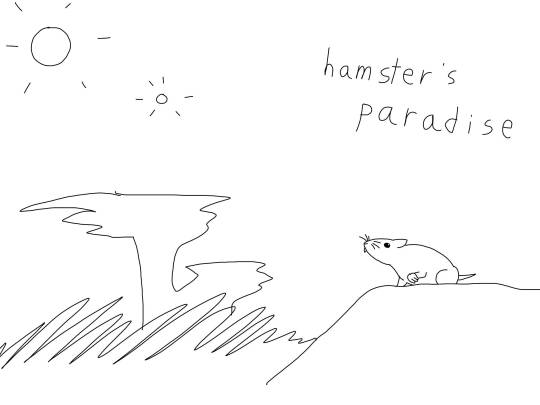
So I've been clearing out my old files and stumbled upon this old scrapped concept I had all the way back since 2017, a seed world project inspired when I first started reading Serina. It was just some random stuff I ended up doing just for fun but I was surprised at all the notes and sketches I'd made of it a long time back, and looking back four years later there may have been quite some really unrealistic evolutionary paths and a rather...pessimistic and kinda misanthropic outlook on sapient species repeatedly evolving and inevitably destroying themselves and the world around them.
But hey, thought it had some interesting ideas so without further ado: "Hamster's Paradise".

The timeline all begins on a suitable, habitable Earth-like planet, orbited by two moons and in a binary system with a yellow sun-like main star and a small orange dwarf that orbited further out and sometimes left nighttime as illuminated as nautical twilight. It was seeded with Earth organisms in preparation to human colonization and all the necessary organisms to maintain a sustainable, habitable biome, with various plants, fungi, decomposers, insect pollinators, marine algae, plankton and the like. However, there were no vertebrate life on the planet save for one test organism introduced to monitor the habitability of the biomes: the Chinese dwarf hamster, Cricetulus griseus.
But for one reason or another, humans never returned to the planet: whether they became extinct, abandoned the project, or managed to colonize another planet, it didn't matter: all that did was that this world was never visited or interfered upon again by human hands. And so, the planet was left to its unlikely colonists: they flourished for the first few million years, experiencing massive boom-and-busts in their population as they repeatedly bred out of control, starved en masse when food dwindled, and the few survivors left to repopulate in the next cycle. Eventually after about 10,000 years the hamsters and the ecosystem began to hit a sustainable equilibrium, and as niches gradually became established, the processes of evolution began to do its work.

The first major epoch of the planet's history would be the Rodentocene Era, where the hamsters, still small but diverse, would begin to diverge into numerous different forms as they came to adopt new lifestyles and occupy new niches. Among these would be running mara-like herbivores, gopher-like burrowers and shrew-like insectivores, while one lineage, evolving longer tails and limbs, would give rise to squirrel-like climbers and jerboa-like hoppers. The biggest creatures at this time would be cavybaras, capybara-sized plains grazers, but throughout the Rodentocene Era, lasting from 1-20 million years post-establishment, none of the rodents would grow particularly large, remaining in small-mammal niches that modern rodents, shrews and lagomorphs would occupy on Earth.
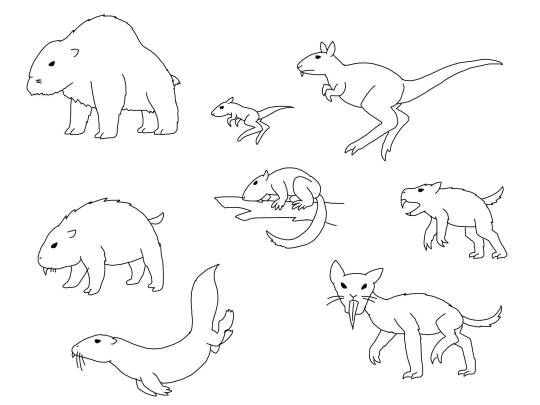
However a world occupied solely by small critters was not to last long, as 20 million years PE the first megafauna began to evolve, occupying bigger and bigger niches. By the 50 million year mark the next epoch, the Therocene Era, was in full swing: large rodents occupying big-mammal niches are widespread throughout all the continents at this point. The cavybaras soon give rise to the buffalo-sized mison and the omnivorous pig-sized bumbaa, the arboreal squirrel-like forms grow into lemur-sized squimians, and aquatic otter and beaver-like species also emerge. The jerboa-like hoppers give rise to the dominant plains grazers of this period: bipedal hoppers resembling macropods, such as the kangaroo-like boingo and its smaller wallaby-sized relative the oingo. Larger predatory forms have also evolved by this point, preying upon their distant relatives: the canid-like hamyena specializing on smaller prey, and the saber-toothed daggarat, which targets larger game such as the mison.
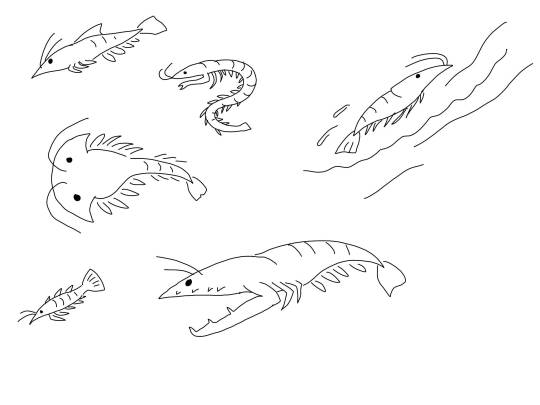
Meanwhile, a different sort of life flourishes in the oceans: in the absence of fish, small swimming krill-like crustaceans evolved into larger aquatic forms, eventually becoming the dominant aquatic lifeforms on the planet: the shrish. The shrish evolve into a diverse array of aquatic species, such as the schooling open-water shrardines, the centipede-like shreel that hunts in coral reefs like a moray, the venomous trilobite-like shringray, the predatory shrark, and a migrating freshwater species, the shralmon, which swims upstream to spawn.
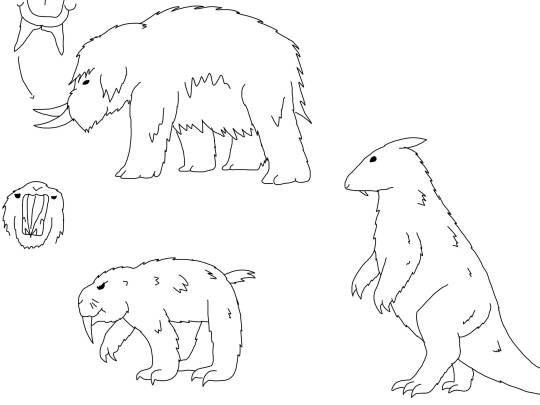
The Therocene Era ends with an ice age that creates large areas of permafrost and tundra, bringing about the Glaciocene Era: 80 million years PE. New forms adapted to the cold develop in the northern continent: a relative of the mison, the rakatusk, grows to elephantine proportions and sprouts a shaggy coat to insulate against the freezing cold, with tusk-like extensions of its incisors serving to dig for food and defend itself from its main predator: the snabre, a lion-sized descendant of the daggarat that fused its upper incisors into a single stabbing blade. Another beast of the ice ages is the lumbering drundle, a nine-foot relative of the boingos and oingos that, having become too heavy to hop, became a plodding bipedal browser, adapting its spine and hips to support such a means of locomotion.

The climate would soon become milder 10 million years later and the icy tundras would shrink, but these cold-clime giants would persist throughout the Glaciocene, and some would later move down to the temperate regions and evolve into new forms. Most notably were descendants of the drundle that would become smaller and nimbler but retain their ancestor's bipedal walking: balanced by horizontal tails and with shorter forelimbs for grasping food, they became the hamstheropods, producing running plains grazers, alpaca-like mountain climbers, and one group of carnivorous predators, the ratptors. The ratptors, however, would be relegated to scavenger and mesopredator status, as the top carnivore niches were filled by the descendants of the hamyena: the carnohams, which sported Thylacoleo-like dentition, with conical stabbing incisors and meat-shearing first molars, and subdivided into two clades, the pack-hunting dog-like gringoes and the stocky, short-legged, strong-jawed bajas.
Other, smaller clades would become widespread in this era. Small, flying ratbats are abundant in the skies, feeding on insects and fruit, the aquatic otter-like species move out to sea and become shrish-eating seal-like phockas, and some of the burrowing gopher-like species become fully subterranean diggers known as horlocks, adapting to the low-oxygen environments underground by having slow metabolisms that lead to them becoming effectively cold-blooded, losing their pelage and converging with naked mole rats.
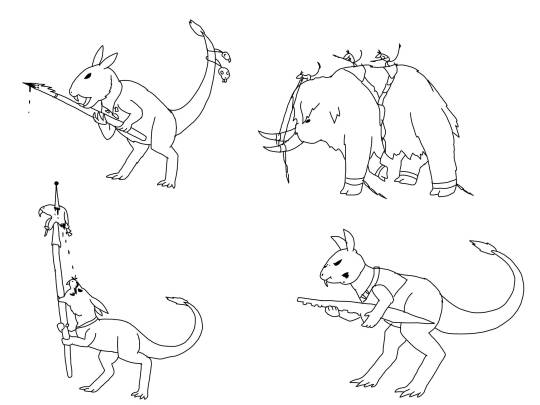
And then, at the end of the Glaciocene, 95 million years after life was first seeded onto the planet, an intelligent species evolves- a species that may very well represent the worst of the worst that sapience had to offer: the harmsters. Descended from pack-hunting ratptors, they were adaptable fast learners and eventually learned how to fell their prey with tools and weapons. The harshly-competitive environment selected for the smartest, most cunning and fiercest of the lot, and soon the harmsters attained self-awareness and soon began to construct a civilization: a civilization centered on war and violence.
As predators selected for both intelligence and ferocity, the harmsters were mentally geared to be incredibly vicious and cruel, displaying a penchant for genocide, bloodsport and even cannibalism, being promiscous breeders that eagerly feasted upon the weakest of their surplus young in bloody rituals. Though they were able to cooperate with each other to some degree, which aided in their construction of a civilization, their culture revolved around a sense of social darwinism, where the strongest were to rule and the weak were killed and devoured. Their violent ways spurred the rise and fall of numerous kingdoms during their brief reign: they engaged in massive wars between kingdoms with casualties numbering in the millions, breeding at rates expected of rodents and thus churning out legions of expendable troops that aided them in invading each other's territories and plundering their enemies' resources. Some of the kingdoms of the northern continent began enslaving rakatusks and comandeering them as weapons of war, living siege engines that trampled the opponents palaces with ease. This strategy would eventually lead to the rakatusk's extinction, as their already-dwindling populations were dragged into battle where they were felled without mercy.
Such a violent, merciless and brutal species was surely not long to last in this world, as they plundered and slaughtered their way across the northern continent driving many species to extinction in their wake, as the harmsters hunted them for food and sport with as much reckless abandon as they did butchering their own kind. Eventually the harmsters would briefly reach an industrial level of technology-- and unsurprisingly, use their newfound technology to create weapons of mass destruction that they turn against their own species. Too bloodthirsty and barbaric for their own long-term good, the harmsters would eventually bring about their own eradication, a mere 13,000 years ever since the first of them discovered the use of tools and began their bloody empires.

The brief rise and fall of an intelligent species ultimately was inconsequential to the grander scheme of life, and it was not long before geological processes swept away all traces of the harmsters' civilization, to be forgotten in the sands of time. In their absence, life simply began anew, in the Temperocene Era: 100 million years PE, a time of mild climates and new diversity that rebounded in the wake of the extinctions brought by the harmsters. The arboreal squimians diversified into monkey-like frugivores and gliding insectivores, while in the seas the phockas, nearly hunted to extinction by the harmsters, rebounded and became fully-aquatic hwhels, some which evolved multi-crowned teeth for catching small swimming prey, and others developing sieving bristles from modified whiskers to filter out zooplankton and krill from the water. On land, the hamstheropods reclaim the lands once ravaged by the wars of the harmsters, their own kin, and become ornithomimosaur-like runners of the savannah, with one group, the nenks, becoming twelve-foot long-necked browsers.
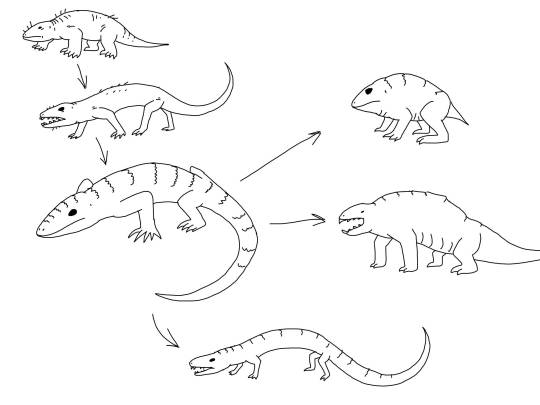
It was also during this warm and humid clime that one of the strangest lineages of the planet would arise. Descended from the burrowing horlocks, some of these unusual new species returned to the surface to exploit vacant niches, regaining their keen eyesight as they came to live above ground once again. The bristly remnants of their fur coats, no longer needed for insulation, would later evolve into overlapping pangolin-like scales to help protect their exposed hairless skins, and their decreased metabolisms, coupled with a long, fat-storing tail, helped them thrive as ambush hunters of insects in warm climates that needed far less food to survive than a typical rodent, using up less energy. With tough scaly skins, a nearly-cold-blooded metabolism, and sprawling limbs as a remnant of their burrowing ancestry, they became the ratptiles: a diverse clade of superficially lizard-like rodents that eventually diverge into long-bodied, flexible short-legged carnivores known as snerpents, herbivorous slow-moving species called biguanas, and even a clade of hopping stocky-bodied insectivorous toadents, which converged heavily on Earthly frogs save for their independence from water when breeding. Like all mammals, ratptiles gave birth to live young: however, they birthed up to thirty tiny but well-developed infants per litter, which were immediately independent from birth and needed no further parental care, simply being born in numbers great enough to ensure at least some would survive by sheer chance.
(Part 2 to be continued...)
#speculative evolution#speculative biology#spec evo#speculative zoology#science fiction#worldbuilding#rodents#hamsters#evolution#hamster's paradise
195 notes
·
View notes
Photo
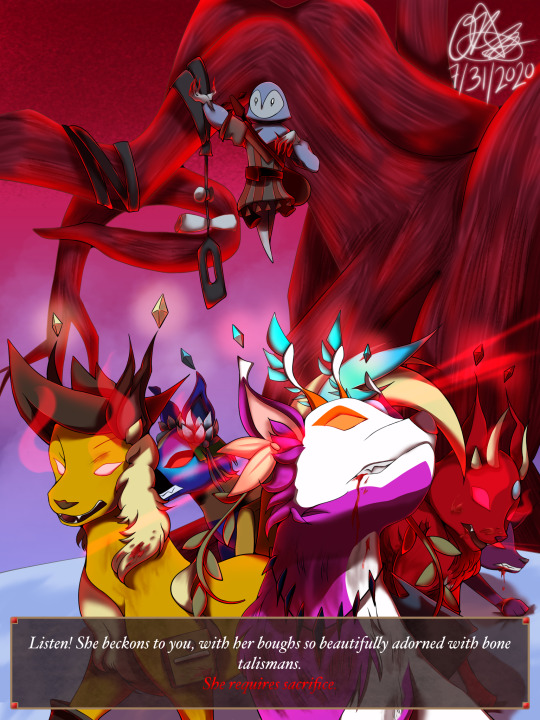
!!TW // A little bit of Blood!! (I’m really sorry I only just remembered)
This took a shit ton of time whoopsies
Context: Fer.al recently released their season pass, and with it a daily quest that requires you to capture/eliminate shrews (yes, the animal) that populated the Blood Tundra, this in turn would be a sacrifice to the Blood Tree. The NPC that activates this quest, Vesta, had a piece of dialogue that interested me, stating that the players were "proxies" of the Tree. And because I have no control when it comes to horror, I quickly came up with this!
#feral wildworks#feral#feralgame#proxy#fer.al#fer.al senri#fer.al kitsune#digital fanart#digital art#digital#digitalartwork#fanart
60 notes
·
View notes
Text
Is there an AU already written where Emmit Otterton did successfully make it to Mr. Big to warn someone about the Night Howlers?
The shrew’s still a mob boss, but he isn’t above working with law enforcement as a “returned favor” and honestly stikes me more as a chaotic neutral/morally dubious vigilante. He also has the sense of community and connections to do something, even if it looks more like putting his own hits on suspected Night Howler snipers in Tundra Town and Little Rodentia.
I dunno if the whole conspiracy would’ve been stopped? But it’s still an intriguing idea to see play out
#zootopia#zootopia au#mr. big#fic request#(also Judy Hopps continues to be a Mood in all the messy ways too)#(there’s just as much to unpack with her character as there is with Nick’s)
15 notes
·
View notes
Text
finnish mammals
majava - European beaver (Castor fiber)
orava - red squirrel (Sciurus vulgaris)
liito-orava - Siberian flying squirrel (Pteromys volans)
tammihiiri - garden dormouse (Eliomys quercinus)
koivuhiiri - northern birch mouse (Sicista betulina)
vesimyyrä - European water vole (Arvicola amphibius)
metsämyyrä - bank vole (Myodes glareolus)
harmaakuvemyyrä - grey red-backed vole (Myodes rufocanus)
punamyyrä - northern red-backed vole (Myodes rutilus)
tunturisopuli - Norway lemming (Lemmus lemmus)
peltomyyrä - field vole (Microtus agrestis)
kenttämyyrä - common vole (Microtus arvalis)
lapinmyyrä - tundra vole (Microtus oeconomus)
idänkenttämyyrä - southern vole (Microtus levis)
metsäsopuli - wood lemming (Myopus schisticolor)
peltohiiri - striped field mouse (Apodemus agrarius)
metsähiiri - yellow-necked mouse (Apodemus flavicollis)
vaivaishiiri - Eurasian harvest mouse (Micromys minutus)
rusakko - European hare (Lepus europaeus)
metsäjänis - mountain hare (Lepus timidus)
siili - European hedgehog (Erinaceus europaeus)
kotipäästäinen - lesser white-toothed shrew (Crocidura suaveolens)
vesipäästäinen - Eurasian water shrew (Neomys fodiens)
metsäpäästäinen - common shrew (Sorex araneus)
idänpäästäinen - Laxmann’s shrew (Sorex caecutiens)
mustapäästäinen - taiga shrew (Sorex isodon)
kääpiöpäästäinen - Eurasian least shrew (Sorex minutissimus)
vaivaispäästäinen - Eurasian pygmy shrew (Sorex minutus)
kontiainen - European mole (Talpa europaea)
vesisiippa - Daubenton’s bat (Myotis daubentonii)
viiksisiippa - whiskered bat (Myotis mystacinus)
ripsisiippa - Natterer’s bat (Myotis nattereri)
pohjanlepakko - northern bat (Eptesicus nilssonii)
korvayökkö - brown long-eared bat (Plecotus auritus)
kimolepakko - parti-colored bat (Vespertilio murinus)
doggilepakko - European free-tailed bat (Tadarida teniotis)
mustavalas - North Atlantic right whale (Eubalaena glacialis)
harmaavalas - grey whale (Eschrichtius robustus)
sillivalas - fin whale (Balaenoptera physalus)
lahtivalas - common minke whale (Balaenoptera acutorostrata)
rhyävalas - humpback whale (Megaptera novaeangliae)
pyöriäinen - harbour porpoise (Phocoena phocoena)
maitovalas - beluga whale (Delphinapterus leucas)
kaksihammasvalas - Sowerby’s beaked whale (Mesoplodon bidens)
valkokuonodelfiini - white-beaked dolphin (Lagenorhynchus albirostris)
rissondelfiini - Risso’s dolphin (Grampus griseus)
miekkavalas - orca (Orcinus orca)
ilves - Eurasian lynx (Lynx lynx)
naali - arctic fox (Vulpes lagopus)
kettu - red fox (Vulpes vulpes)
susi - grey wolf (Canis lupus)
karhu - brown bear (Ursus arctos)
ahma - wolverine (Gulo gulo)
saukko - Eurasian otter (Lutra lutra)
kärppä - stoat (Mustela erminea)
vesikko - European mink (Mustela lutreola)
lumikko - least weasel (Mustela nivalis)
hilleri - European polecat (Mustela putorius)
näätä - European pine marten (Martes martes)
soopeli - sable (Martes zibellina)
mäyrä - European badger (Meles meles)
supikoira - raccoon dog (Nyctereutes procyonoides)
mursu - walrus (Odobenus rosmarus)
halli - grey seal (Halichoerus grypus)
grönlanninhylje - harp seal (Pagophilus groenlandicus)
norppa - ringed seal (Pusa hispida)
villisika - wild boar (Sus scrofa)
hirvi - moose (Alces alces)
metsäkauris - roe deer (Capreolus capreolus)
peura - reindeer (Rangifer tarandus)
21 notes
·
View notes
Text
Here’s a Pokemon team I think I would have based on where I live

First of all I live in Wisconsin so I really have no access to deserts or oceans or jungles so that rules alot of things about. I also like the idea that I wouldn’t have a starter pokemon. Don’t get me wrong I love starters but I like the idea of not having one on a team. Like maybe I couldn’t afford one or there’s no professor around close enough to get one.
And also I’d like to think about the availability of each pokemon aka how rare and hard they are to catch and what about legendaries so of course I know i’d never catch a legendary and harder pokemon would be a struggle for me.
1.Parasect. We kinda have a bit of fields and a few woods or forests around. And as I am a bug type enthusiast I thought a Parasect would be fitting. Yes he’s not the most popular bug type but I really do like him and I feel like I’d catch a little paras easily.
2. Magikarp. I wanted a water type and thought about how I really don’t have access to the sea. So nothing like a Sharpedo or some tropical fish. After playing Magikarp Jump I kinda found myself loving Magikarp a bit more then just ‘a useless fish’ So I think i’d have one. Not yet a Gyarados but maybe one day but i’m just happy with my Magikarp
3. Alolan Sandshrew. I know it’s not... Alola here but I wanted an Ice type that wasn’t like ‘i live in a tundra’ but still ‘it’s snowy’. We have a couple of shrews and moles around here, and there’s even a story of my grandma having a little mole stuck in a tube in her basement (we got it out don’t worry). I also like Steel types so I think a little igloo shrew would be perfect.
4. Gumshoos. I honestly fell in love with Gumshoos when playing Sun and Moon. I’m not one for the ‘normal rat’ pokemon you find at the beginning of the game but I don’t know something about Gumshoos and the one I had was good. I love the detective design and it’s really funny just to think of one trying to solve a mystery. It and yungoos don’t deserve the hate they get.
5.Houndoom. I wanted a fire type as I thought ‘well being in a cold area a fire type would be good’ and I was really debating between a few dog like pokemon. I’m usually a cat person but I love cats and dogs equally, we just end up with a ton of cats. But I think having a houndoom would be nice. Houndooms probably get a bad rep for you know... looking like a hell dog but I think one would fit in nice.
6.Shedninja. Ending it with another bug pokemon cause I can’t help myself. I love Sheninja’s gimmick. 1 hp pokemon with an ability that makes it a god (until you get a super effective move or some toxic/burn) but still. Plus it’s a ghost pokemon and those are always cool. I imagine I’d just find one in the woods. Just the shell just kinda floating there and capture it and love it up.
19 notes
·
View notes
Text
the signs as animals
arist: south african cheetah
aries: american black bear
argo: kordofan giraffe
arga: griffon vulture
arittanius: wildebeest
arittarius: yak
arpio: bowhead whale
arpia: african elephant
arlo: horse
aro: barn owl
ara: tiger
arza: white rhinoceros
aricorn: spider monkey
ariborn: ring-tailed lemur
arnius: tabby cat
arius: megabat
asci: rock dove
asces: pied crow
armino: lion
armini: eurasian wolf
arcer: gerbil
arcen: newt
arus: bush-tailed porcupine
arun: philippine forest rat
taurrist: asiatic cheetah
taurries: asian black bear
taurgo: nubian giraffe
taurga: cinereous vulture
taurittanius: roan
taurittarius: southern marsupial mole
taurpio: right whale
taurpia: asian elephant
taurlo: sea eagle
tauro: grass owl
taurra: sheep
taurza: sumatran rhinoceros
tauricorn: vervet monkey
tauriborn: aye-aye
taurnius: jungle cat
taurrius: flying fox
taursci: trocaz pigeon
taursces: american crow
taurmino: kit fox
taurmini: tundra wolf
taurcer: guinea pig
taurcen: seal
taurus: crested porcupine
taurun: nile rat
gemrist: north american cougar
gemries: atlas bear
gemgo: west african giraffe
gemga: white-rumped vulture
gemittanius: waterbuck
gemittarius: northern marsupial mole
gempio: blue whale
gempia: blue-ringed octopus
gemlo: snake-eagle
gemo: sooty owl
gemra: argali
gemza: black rhinoceros
gemicorn: proboscis monkey
gemiborn: sifaka
gemnius: european wildcat
gemrius: egyptian fruit bat
gemsci: laurel pigeon
gemsces: cape crow
gemmino: red fox
gemini: arabian wolf
gemcer: dove
gemcen: house mouse
gemus: long-tailed porcupine
gemun: moluccan prehensile-tailed rat
canrist: florida panther
canries: blue bear
cango: reticulated giraffe
canga: black vulture
canittanius: eland
canittarius: golden mole
canpio: bryde’s whale
canpia: dumbo octopus
canlo: black-chested buzzard-eagle
cano: itombwe owl
canra: mouflon
canza: indian rhinoceros
canicorn: pygmy marmoset
caniborn: mouse lemur
canius: black-footed cat
canrius: california leaf-nosed bat
cansci: hill pigeon
cansces: hooded crow
canmino: cape fox
canmini: steppe wolf
cancer: humming bird
cancen: mayor’s moue
canus: bristle-spined rat
canun: bulldog rat
lerist: african leopard
leries: eurasian brown bear
lego: angolan giraffe
lega: turkey vulture
leittanius: gerenuk
leittarius: eurasian beaver
lepio: fin whale
lepia: mimic octopus
lelo: black solitary eagle
leo: bay owl
lera: urial
leza: nile hippopotamus
leicorn: rhesus macaque
leiborn: cockatiel
lenius: sand cat
lerius: hondurian white bat
lesci: snow pigeon
lesces: somali crow
lemino: arctic fox
lemini: mongolian wolf
lecer: flying squirrel
lecen: sikkim mouse
leus: prehensile-tailed porcupine
leun: kerala rat
virrist: javan leopard
virries: eurasian brown bear
virgo: south african giraffe
virga: california condor
virittanius: steenbok
virittarius: north american beaver
virpio: see whale
virpia: blanket octopus
virlo: crested eagle
viro: scops owl
virra: bighorn sheep
virza: east african hippopotamus
viricorn: gibbon
viriborn: parrotlet
virnius: chinese mountain cat
virrius: big brown cat
virsci: specled pigeon
virsces: flores crow
virmino: fennec fox
virmini: dingo
vircer: unstriped ground squirrel
vircen: volcano mouse
virus: electric eel
virun: himilayan field rat
librist: northern goshawk
libries: grizzly bear
libgo: masai giraffe
libga: greater flamingo
libittanius: nyala
libittarius: star-nosed mole
lipio: chilean dolphin
lipia: coconut octopus
liblo: harpy eagle
libo: screech owl
libra: thinhorn sheep
libza: cape hippopotamus
libicorn: bornean orangutan
libiborn: caique
libnius: amazon weasel
librius: dwarf epaulettes fruit bat
libsci: wood pigeon
libsces: bismark crow
limino: grey fox
limini: dog
libcer: indian palm squirrel
libcen: indian field mouse
libus: hog-nosed skunk
libun: sunburned rat
scorrist: gray-bellied hawk
scorries: east siberian brown bear
scorgo: thornicroft’s giraffe
scorga: lesser flamingo
scorittanius: klipspringer
scorittarius: hairy-tailed mole
scorpio: arabian dolphin
scorpia: giant squid
scorlo: papuan eagle
scoro: snowy owl
scorra: snow sheep
scorza: west african hippopotamus
scoricorn: sumatran orangutan
scoriborn: lorikeet
scornius: mountain weasel
scorrius: split-nosed bat
scorsci: comoros olive pigeon
scorsces: white-necked crow
scormino: swift fox
scormini: tibetan wolf
scorcer: eastern grey squirrel
scorcen: ryukyu mouse
scorus: hooded skunk
scorun: aceh rat
sagirist: red-chested goshawk
sagiries: syrian brown bear
sagigo: pig
sagiga: chilean flamingo
sagiittanius: kudu
sagiittarius: eastern mole
sagipio: long-beaked dolphin
sagipia: colossal squid
sagilo: balck eagle
sagio: great horned owl
sagira: red kangaroo
sagiza: angola hippopotamus
sagiicorn: tapanuli orangutan
sagiiborn: parakeet
saginius: steppe polecat
sagirius: brown long-eared bat
sagisci: white-naped pigeon
sagisces: jungle crow
sagimino: plains bison
sagimini: japanese wolf
sagicer: colorado chipmunk
sagicen: cook’s mouse
sagius: striped skunk
sagiun: snake
capririst: besra
capriries: giant panda
caprigo: chicken
capriga: jame’s flamingo
capriittanius: lechwe
capriittarius: gansu mole
capripio: killer whale
capripia: humboldt squid
caprilo: spotted eagle
caprio: eagle owl
caprira: eastern grey kangaroo
capriza: north american ostrich
capriicorn: eastern gorilla
capriiborn: pianos parrot
caprinius: long-tailed weasel
capririus: mediterranean horseshoe bat
caprisci: stork
caprisces: fish crow
caprimino: wood bison
caprimini: indian wolf
capricer: grey-collard chipmun
capricen: cypriot mouse
caprius: spotted skunk
capriun: spider
aquarist: long-tailed hawk
aquaries: sloth bear
aquago: red junglefowl
aquaga: andean flamingo
aquittanius: springbok
aquittarius: long-tailed mole
aquapio: pilot whale
aquapia: japanese flying squid
aqualo: tawny eagle
aquo: fish owl
aquara: western grey kangaroo
aquaza: masai ostrich
aquicorn: western gorilla
aquiborn: cockatoo
aquanius: yellow-bellied weasel
aquarius: raccoon
aquasci: goose
aquasces: house crow
aquamino: european bison
aquamini: arctic wolf
aquacer: gray-footed chipmunk
aquacen: steppe mouse
aqus: fattail scorpion
aqun: alligator
pirist: chanting goshawk
piries: polar bear
pigo: cow
piga: american flamingo
piittanius: sable antelope
piittarius: japanese shrew mole
pipio: houglass dolphin
pipia: vampire squid
pilo: camel
pio: spotted wood owl
pira: antilopine kangaroo
piza: arabian ostrich
piicorn: chimpanzee
piiborn: conure
pinius: european mink
pirius: koalas
pisci: duck
pisces: palm crow
pimino: water buffalo
pimini: baffin island wolf
picer: uinta chipmunk
picen: meerkat
pius: pandinus
piun: crocodile
#homestuck#zodiac#extended zodiac#the signs as#long post#originality is overrated#i spent way way way way too long on this thing
671 notes
·
View notes
Link
First fiction writing after I moved into Scotland. Trying to adapt myself to all the new environment. Still excited for all new things ahead of me~ Wish y’all doing great
Clawhauser: Ah geez, this looks bad. This looks bad! It’s not good at all!
Finnick: Quiet down, Spots… Seriously, do I really have to do this recap sequence thing?
Clawhauser: Judy and Nick are going through hardships. They aren’t available right now... Besides, I don’t wanna do this alone.
Finnick: Isn’t there somebody else who would like to fill in?
Clawhauser: There is… but I’d rather not work with him… at least for now.
Finnick: Fine… Previously on Zoomorphia, after nonstop teleportation tired our fuzz bunny out, Slick suffered from mysterious hunger. He chowed down so much his belly puffed up.
Clawhauser: Poor thing…
Finnick: I agree. He got so fat I pitied his pants! Hahaha… Just so you know, I don’t have anything against fat mammals.
Clawhauser: Don’t worry. As a matter of fact, I’m not fat… I’m fluffy~ Anyway, thank you for calling Judy. She really did calm Nick down easily.
Finnick: They went out to fight the Savages afterwards. Fluff talked on the phone before they transformed right? Where did her phone go after that?
Clawhauser: That’s what I always ask! But the important issue here is that they two as Hybrid got badly injured by the bull monster. What will happen!? Will Judy be okay!?
Finnick: Find out in this chapter. Chapter 15
Fanfiction.net
.-.. . - .----. ... / -.-. --- -. - .. -. ..- .
“Judy! Judy!” Nick got off the sofa in haste after Judy, catching him off guard and detransforming, sent his mind back to his own body.
Experiencing fatigued like always, he collapsed on Finnick’s apartment floor, baffling his old pal, Finnick, and the feline friend, Clawhauser.
“Judy… Judy...” He continued calling to her while crawling wearily before he realized how to deal with the pesky tiredness. He then moved his paw down to push the syringe on his morpher, injecting the blood.
“Nick! What’s wrong!?” Clawhauser kneeled down next to Nick.
“You keep saying Fluff’s name. What’s happening to her?” Finnick tried to help the fox up despite his height.
Nick, finally regaining his strength, stood up slowly. Nevertheless, he was still suffering from discomfort in his overstuffed belly.
“We as Hybrid were gored right in stomach and Judy detransformed before the wound can be properly healed. And now, she-... she is enduring all the pain alone...” He said with fear.
“I’ll call an ambulance.” Clawhauser, still kneeling, was dialing his phone.
“How will we explain to doctors and nurses what caused her stab wound?” Finnick jumped and snatched Clawhauser’s phone from his paw, “Hybrid secret would be put at risk.” thinking that others would have doubts about why Judy’s wound looked like she got stabbed with horn and it was the same spot as Hybrid’s, which could lead to drawing connections.
“But Judy’s life is at stake right now!” Clawhauser tried to take his phone back.
Meanwhile, Nick felt that the pain in his stomach cannot be compared with the pain of the stab wound from the bull Savage’s horn. Although he experienced that stab wound pain while being Hybrid whose body was fairly stronger than average mammals, he could not imagine how much pain the doe rabbit felt at the moment.
He was racking his brain trying to think of what he should do, how he could save his dear bunny friend, but he then came up with an idea.
- .-. . -- -... .-.. .. -. --.
The injured unconscious gray European rabbit was lying prone not far from the corner of one building in the downtown, breathing weakly.
“I’ve found her.” Bolt in the Alaskan tundra wolf disguise jumped from rooftop to rooftop until he was able to locate Judy’s whereabouts.
“Retrieve her at once! We can’t afford to lose one or the other of Hybrid.”
Bolt heard Mittens speaking through their private wireless communication system installed in him.
“Tell me about it.” Bolt was going to go down to save the doe. Since he was unable to switch on or change into his silver chrome form, he planned to go down the stairs like a normal mammal.
However, when he was turning back, about to head to a stairwell of the building, he caught a glimpse of a black limousine coming to a halt around the corner. Hence, he turned his face back swiftly to get a good look.
A large polar bear, wearing a dark suit with two vertical blue stripes on each sleeve, got out of the limo. He looked around before he showed a thumb up signal. Subsequently, another similar-looking polar bear charged out the limo to the unconscious bunny. He picked her up fast yet carefully. After both bears got back in the luxury vehicle hurriedly, it departed immediately.
“Mittens!!” Bolt shouted, nonplussed by what he had just witnessed, which seemed as if Judy was kidnapped by the shady polar bears.
“I’m on it.” In the motorhome, Mittens was hacking into traffic cameras in order to track down where the limousine was heading to.
“There’s no way you can catch up with that car unless you transform. Retreat!” She sounded irritated as if she reproached him for not allowing her to check his arm earlier.
Some time later, Bolt returned to the motorhome on the outskirts of Savanna Central as he was told by his wildcat friend. Once he opened the door, he crossed his arms above his head to defend himself from an attack of Mitten’s paper fan because he thought that she would still be mad at him and wait for him.
Nonetheless, there was no loud noise that usually happens whenever she slaps him with her trustworthy fan.
“Come in. I don’t have all day to play around.” Mittens, sitting at a computer, was occupied in tracking down the limousine racing down the road.
As a result, Bolt entered the motorhome carefreely. However, he was then slapped loudly at the back of his head.
“Oh, my stars and garters! This thing is a fantastic stress reliever!”
He looked back at a owner of an electrifying deep voice. The mammal, holding the paper fan behind him, was a black sloth bear in round glasses, a yellow Hawaiian shirt and blue shorts with white linings.
“Thank you for doing me a favor.” Mittens sneered.
“Hi Professor” Bolt smiled sheepishly, believing his wildcat friend must ask the sloth bear to hit him for her.
Professor threw the fan in his paw lightly on a close by couch. “Gimme your arm”
The Alaskan tundra wolf took off his jacket and stuck his right arm out to the bear.
“Voilà” He fixed the stuck zipper in no time.
“Shut the front door!” Bolt got shocked to see how easily he fixed it.
“Go sit at the table.” Professor led the wolf to sit on one of the two couches that were placed opposite each other with the table in the middle. Moreover, these couches in addition to other stuffs in the motorhome were clearly meant for larger mammal. Thus, there was plenty of space.
Rhino the lemmings, who had already sat on the couch that Bolt went to sit on, climbed up to seat himself on the couch rest.
On the other hand, “I can’t leave my computer yet but I’m listening.” Mittens said, working hard on her task.
“Okay, let’s cut to the chase, shall we?” Professor, sitting opposite to Bolt and Rhino, leaned forward, laying clasped paws on the table.
“Currently, as we speak, we have zero clue whether Ms. Hopps is dead or alive. The worse case is she’s goner by now, which means there’s nothing we can do.” Professor informed.
All three other mammals fell silent. Shortly, he continued. “Conversely, if it turns out she survives…, that would be a great news but!” He emphasized the word. “Can we be certain that next time or next fight, everything’s gonna be alright?”
“Bolt will be there to help-”
“I hate to burst your bubble, but even I ain’t sure if something like this happens again to either of them, I will be able to save them...” Bolt cut in while Rhino was speaking in an optimistic tone.
Professor, who was also thinking the same thing, became less worried when he saw that Bolt himself was fully aware. “We can’t afford to risk that couple’s lives.”
“Couple?” Bolt and others were confused by who professor referred to. Even Mittens turned away from the computer screen to react.
“Y’know, Officer Wilde Hopps”
“As far as I’m concerned, they don’t have… a thing.” Mittens said to professor, taking an interest in bunny fox officers’ affair more than her task.
“See, Mittens! I’m not only one here who misunderstood!” Rhino yelled.
“We don’t have time to argue.” The annoyed wildcat got back to work on her computer, pretending to act mature by focusing on her tracking task.
“Anyhow” Professor got out of the couch, turning to the computer screen. “As soon as Mittens can locate Hopps, go to check on her straight away. And if she’s safe,... you know what to do… in order to diminish the risk.” He looked at Bolt out of the corner of his eyes.
... .- ...- . / - . ... - / ... ..- -... .--- . -.-. - …
It felt as if she was sinking down into the silent and pitch-black ocean alone. Her body also felt heavier and colder to the point that it was difficult to move. She saw nothing but a darkness.
Out of the blue, the light glowed bright above her from a distance. She then reached out to the glow, yet it was too far away.
Subsequently, a warmness touched her right paw before her body was dragged up to the light.
Following that, Nick grinned, holding Judy’s right paw tighter after her fingers flicked. She had been fallen into deep slumber on a sickbed size of which was for someone her size as the IV infusion was put in her left arm.
Once Judy woke up, opening her eyes slowly, Nick “Judy!!” called her name with the greatest pleasure.
At that time, it was late evening in Tundratown, at Mr. Big’s house to be exact. The limo which took Judy away from Downtown and Finnick’s van were parked in a garage belonged to the infamous old Arctic Shrew. Besides, Hybrid Police form’s black hatchback sports car with white doors and a pair of sirens on the top was kept in this garage among Mr. Big’s luxury cars.
Nick decided to contact Mr. Big earlier for help because there were only a few mammals who knew about Hybrid’s secret and gave them support, not to mention had enough private health resources in his house since his men sometimes cannot be admitted to normal hospitals as a result of his mafia business.
Clawhauser and Finnick were sitting quietly on leather sofas while waiting in such a fancy sombre living room for any Judy’s condition updates. The plump cheetah officer in civilian clothing was tense with fear to be surrounded by intimidating polar bears, whereas his small fennec fox friend appeared rather relaxed.
He peeked at a large and probably the most intimidating polar bear who has thick eyebrows and a fat neck and wore a black business suit over a black turtleneck along with two golden necklaces, believing that this polar bear must be Mr. Big, the most feared crime boss in the icy Easternmost district of Zootopia. He had heard of him before but got shocked when he learned that his friend Nick had a connection with the crime boss, wondering why a mafia helped a cop like Judy willingly.
Next, he noticed a golden-brown furred Arctic shrew in a fashionable mint green dress walking in circles worriedly on a well-crafted coffee table, so he moved to sit closer to the table.
“Hi” Clawhauser friendly greeted the female Arctic shrew, “I see you’re having a rough time.” slightly frightened by the stare from polar bears when he opened the conversation with her.
She stopped walking to talk with the cheetah, “Thank you for calling us earlier.” bowing to him.
“No need to thank us.” Clawhauser scratched his right cheek softly. “I mean… Judy is our friend. Of course we help her.”
“I hope she’s safe and sound.” The female Arctic shrew sighed as she was looking down on the table surface.
Swallowing his own saliva, Clawhauser wanted to reassure her, yet he himself was unsure...
“She’s gonna be just fine.” The male high-pitched voice came from Koslov, the polar bear who was wearing the golden necklaces, but he obviously had not spoken any words.
He walked towards Clawhauser with an old Italian shrew in a black suit and bow tie on his paws.
“My child is a good mammal. Good deeds would protect her.” The high-pitched voice evidently belongs to him.
Clawhauser thought this old shrew looked dignified and was really kind towards Judy.
“I haven’t introduced myself yet. Benjamin Clawhauser”
“My name is Fru Fru and here’s my daddy.”
“Nice to meet you Fru Fru and Mr...” Clawhauser supposed that it would be weird to call the old shrew Fru Fru’s dad.
When the old shrew was about to say his name, all of a sudden, “Hopps just awoke.” Raymond, a polar bear wearing a dark jacket with vertical blue stripes on sleeves, rushed into the room. A dollar sign pendant, connected to his gold necklace around his neck, was shaken by his rapid movement.
Consequently, almost everybody, mainly Clawhauser, Fru Fru, her father and Koslov, left the living room right away.
While Finnick was going to follow others out of the room, “We need to talk.” Raymond the polar bear obstructed him.
“If you gonna break up with me, at least, take me out for dinner or something first.” Finnick joked.
“I’m serious.” Raymond used a stern tone. “Did Hopps really get gored in her stomach?” He asked the small sandy fox.
“According to Nick, yes. Why do you ask?”
Raymond kept silent for a while before answering Finnick. “It’s true that she bled when we went to bring her here… However, her body didn’t show a sign of severe blood loss, so there was no need for a blood transfusion.”
“On top of that, her wound was shallower than expected. It even got surprisingly better by the time she arrived on a sickbed. Although it’s wonderful that her injury isn’t serious anymore, this is...”
Finnick finished Raymond’s sentence. “too strange...”
.- -... -. --- .-. -- .- .-.. .. - -.--
Nick returned to Judy after poking his head round the door to quickly tell Raymond, who at the moment acted as a guard standing in front of the room where the bunny was recuperating, about Judy regaining consciousness.
He briskly went back to be at her side.
“Nick...” Judy spoke drowsily “Are you alright? Do you hurt anywhere?” and concernedly.
Nick chuckled in response, “Dumb bunny, you should worry about yourself before others.” taking hold of his precious bunny friend’s right paw tenderly.
Their private moment which felt like eternity did not last very long before other mammals bursted into the room. Nick was letting go of Judy’s paw with intention to allow others to come talk to her but she was still holding on to his paw weakly, which he interpreted as ‘she did not want him to leave her side.’. Nick therefore moved up to the bed, so the others could gather around her.
Clawhauser and Fru Fru, who was standing next to her father on the polar bear’s paws, questioned about Judy’s health persistently. She could only smile due to being unable to follow what both were saying to her.
“Calm down you two. She just woke up. Let her recover first.” The old shrew said.
Getting a hold of themselves, both felt guilty for unintentionally disturbing the rabbit doe.
“I guess you must be the one who saved me. Thank you” Judy thanked the old shrew.
“Don’t mention it. In fact, you should thank Nicky.” He recalled when Nick phoned him, so he could send his henchmen to help her in time.
“Thanks, Nick” She tightened her grip, turning her gaze to him. He could sense her warmness in his paw and sweetness in her eyes.
Smirking, “This’s for making me worried sick, Carrots.” Nick flicked Judy’s forehead lightly with his index finger.
“Nick!!” Clawhauser “Nicky!!” and Fru Fru shouted in a rebuking manner.
“Don’t you ever pull a stunt like that again.” Even though Nick jokingly scolded Judy, his words contained sincerity.
Then, a polar bear came into the room panting like he just ran, bending down and whispering to the old shrew on Koslov’s paws. Although he spoke sotto voce, the sensitive ears of a rabbit could hear him saying. “There’s an intruder in the front yard.”
“I need to run an errand. Baby, keep Judy company, okay?” said the old shrew.
Koslov put Fru Fru down on the foot of the temporary sickbed before following the panting polar bear out of the room together with the old shrew.
After that, Judy struggled to get off the bed, so others tried to stop her.
“Get to little Judy ASAP.” Judy told Fru Fru to go to her daughter at once.
“What’s wrong?” The confused cheetah worried that Judy’s condition might get worse if she forced herself.
“I’m having a bad hunch.” She replied.
“Even so, you should have some rest.” Nick suggested her caringly.
“Nick… please...” She begged as she was holding his paw tighter.
At first, the old shrew thought that this intruder must be one of the craziest mammals who dare to beard someone like him in his den but once the house’s owner arrived on the scene, he saw the wolf whose polished silver chrome body was reflecting moonlight. On the snow filled front yard, the polar bears encircled the mysterious wolf rumored to be some sort of vigilantes.
Soon after sending signals to each other, frightening mafia members charged at Bolt all together. The surrounded wolf, arms glowing, dodged the mammals rushing to attack him and pushed them away with his silver chrome paws.
Despite being hit lightly, the bears fell over in the snow, unable to move their bodies as they pleased. The reason behind phenomenon was Bolt used minor electric shock on them, leading to numbness in the whole bodies.
The old shrew grew anxious to see his henchmen were no match for a single opponent but he became more anxious when “Mr. Big!!” Judy showed up behind him with Nick propping her up against him. She was placing a cotton ball on her puncture wound on her left arm as a result of Intravenous therapy.
Meanwhile, Clawhauser stayed with Fru Fru in the house to protect her child.
“What are you doing here!? Go back!!” Mr. Big the Arctic shrew yelled at the duo.
Hearing a yell, Bolt shoved one of the polar bears out of the way. He finally found the bunny cop. “You’re safe! What a relief~ I’ve come to rescue you.” He said.
“I don’t know why you bother to rescue me but you’re the only one causing trouble here, so beat it.” Judy, acting tough, chased Bolt away. She knew well that her condition at the time was far from capable of arresting the agile silver chrome wolf.
“Okay… Well, the thing is...” Bolt spoke awkwardly. “I need both of you to hand over your drivers.” He pointed at Nick and Judy.
“Why do you need them?” Nick asked, darting a glance at Judy wearing her MidniDriver. He admitted that it was a right idea to be prepared against the wolf in spite of his worry for his partner’s health. He consequently put on his morpher, belt of which was a little too tight around his still expanded waist, and “DRAW BLOOD” teleported a portion of his blood to a syringe on the left side of the doe’s transformation gear.
“Sorry, I can’t answer that. It’s confidential.” The wolf, rubbing the back of his neck, looked the other way. “But I suppose no matter what…, you two wouldn’t give them to me willingly.”
While Bolt was talking, one bear sneaked up behind him. Before Mr. Big’s henchman could catch the silver wolf, he “Accel” did a high backflip, then landed on the bear’s left shoulder.
Hurriedly, the accelerated mechanical wolf dashed towards the doe rabbit, passing Koslov and Mr. Big easily.
Lifted up from the ground, Judy was locked in Bolt’s arms. At the time that her transformation belt was so close to getting stolen by the wolf, “INJECT” “IGNITE” she hastily transformed.
“Transform!” When the bunny shouted, Koslov quickly grabbed the fainting fox and then ran away.
The scorching purple mist explosion from transformation blew Bolt the silver wolf away, causing him to drop the bunny’s body.
Subsequently, the flamingo red armored hybrid between a leporid and a canine with color scheme of Nick’s casual clothing, vertical blue stripe in the front middle of light green torso and grayish-tan lower body excluding the feet, appeared among the fading mist.
Hybrid in a crouching position, feet wide apart, right knee and outstretched right fist in contact with the snow on the ground, tilted the head back to direct gaze at Bolt, who fell on his buttlock after the explosion.
The wolf stood up promptly. Both sides were ready to go head to head against one another. Judy felt her body getting better gradually as it seemed that it recovered faster while being Hybrid.
“I give ya 10 seconds for clearing this area. It won’t be pretty if these poor bears get caught in the crossfire during the fight.” Bolt informed.
Accordingly, Mr. Big sent more of his henchmen to bring the paralyzed polar bears out of the front yard back into his house.
Once the area was cleared, Hybrid and Bolt, sprinting, crashed into each other.
“Don’t push yourself too hard!” Mr. Big warned Judy worriedly.
“I’m here with her, so please rest assured.” The fox in Hybrid body told the shrew.
Hybrid was stopping the wolf’s kick aiming at the head, sensing the force exerted into his leg, still Hybrid could withstand even much higher force.
His arms glowing again, Bolt pulled his leg back, making Hybrid lose balance, then “Volt Strike” thrusted one of his paws downward with an intention to give the opponent a electric shock.
Hybrid dodged the glowing arm and hopped up before flipping in mid air to “ACTIVATE” deliver a powerful kick right in Bolt’s occiput.
The accelerated wolf ducked the attack swiftly. Next, he swung his leg and struck Hybrid with the front of his foot in the air, sending the armored mammal to land on feet nearby him.
Seeing that the Hustler form may not be the right choice to fight against the silver wolf, Hybrid twisted the handle on the right side of MidniDriver forth one time, “FORM SHIFT-POLICE” turning into the flamingo red armored mammal in Judy’s blue police field uniform, Police form, prior to instantly “ACTIVATE” summoning the AutoMag.
Twisting the handle back “CRITICAL BREAK”, Hybrid Police form fired an energy ball which shortly exploded like a firework. The burning lights from a mouth of the pistol in Hybrid’s left paw bent to strike down the wolf.
“Triple accel” uttering calmly, Bolt moved from side to side like greased lightning and lowered his body a few times. Thanks to his highly accelerated processor, he was able to see through the attack and avoid all of the light beams hitting him.
Horrified, the united duo was speechless to witness their opponent standing in front of them unscratched.
Bolt cancelled his acceleration in order to avoid overheating, then “Volt Strike” threw a radiant right punch. Due to being shocked, the duo’s response was slightly slow. Hybrid barely blocked the punch in time, falling over and rolling on the snow.
“Even Police form’s finisher...” Judy tried to get back up. Hybrid’s arms shook as a result of the electric shock earlier.
“At this rate, they can’t defeat that wolf.”
The duo overheard the polar bears discussing quietly because of Hybrid’s enhanced hearing. Even though she did not want to, she agreed with them to some extent.
“Judy...” Nick said her name, so she turned her attention to him.
“We should use my body to transform...” He suggested.
Judy paused. His suggestion reminded her of that fateful night… the night that changed their fate forever.
- --- / -... . / -.-. --- -. - .. -. ..- . -..
1 note
·
View note
Photo
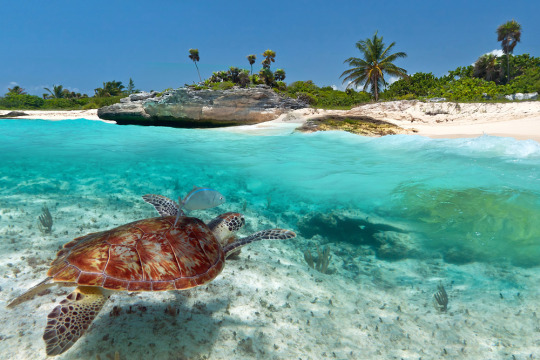
Wildlife Species of Mexico
Mexico is rich in wildlife species resulting from its range of ecosystems and habitats that include lowland tropical rainforest, temperate desert, montane forest and alpine tundra. It boasts over 800 species of reptiles and over 500 species of mammals and the highest number of rodent species in the world.
Mammals
Mammal species found in Mexico include opossums, manatees (fully aquatic herbivorous mammals), armadillos, sloths, anteaters, tamanduas, howler and spider monkeys, porcupines, agoutis, pacas, squirrels, chipmunks, beavers, gophers, prairie dogs, tapirs, kangaroo rats, voles, shrews, bats, whales and dolphins. Amongst the carnivores are ocelots, pumas, Mexican wolves and Mexico’s national mammal, the jaguar.
Birds
Mexico’s national bird is the golden eagle. Mexico is also home to albatrosses, tropicbirds, boobies, frigatebirds, snake-birds, pelicans, flamingos, vultures, macaws, parakeets, owls, hummingbirds, toucans, trogons, flycatchers and the tinamou amongst countless others.
Reptiles
The national reptile of Mexico is the green turtle with seven of the eight sea turtles of the world living and breeding in Mexico. The country is home to numerous species of lizards, four species of crocodiles and over 380 species of snakes. The Yucatan Peninsula alone boasts over 180 species of reptiles and amphibians.
Are you interested in spotting all of the various wildlife species in Mexico? Chimu Adventures offers tours to South America and Central America as well as tailor-made packages. Click here for more information.
0 notes
Photo
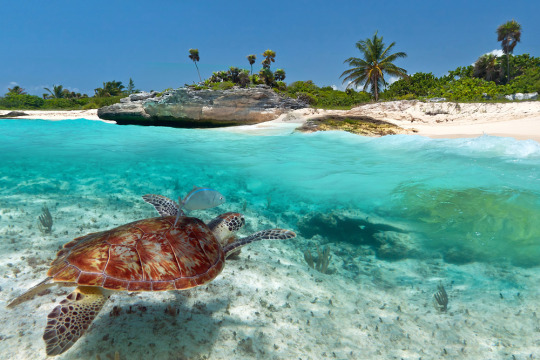
Wildlife Species of Mexico
Mexico is rich in wildlife species resulting from its range of ecosystems and habitats that include lowland tropical rainforest, temperate desert, montane forest and alpine tundra. It boasts over 800 species of reptiles and over 500 species of mammals and the highest number of rodent species in the world.
Mammals
Mammal species found in Mexico include opossums, manatees (fully aquatic herbivorous mammals), armadillos, sloths, anteaters, tamanduas, howler and spider monkeys, porcupines, agoutis, pacas, squirrels, chipmunks, beavers, gophers, prairie dogs, tapirs, kangaroo rats, voles, shrews, bats, whales and dolphins. Amongst the carnivores are ocelots, pumas, Mexican wolves and Mexico’s national mammal, the jaguar.
Birds
Mexico’s national bird is the golden eagle. Mexico is also home to albatrosses, tropicbirds, boobies, frigatebirds, snake-birds, pelicans, flamingos, vultures, macaws, parakeets, owls, hummingbirds, toucans, trogons, flycatchers and the tinamou amongst countless others.
Reptiles
The national reptile of Mexico is the green turtle with seven of the eight sea turtles of the world living and breeding in Mexico. The country is home to numerous species of lizards, four species of crocodiles and over 380 species of snakes. The Yucatan Peninsula alone boasts over 180 species of reptiles and amphibians.
Are you interested in spotting all of the various wildlife species in Mexico? Chimu Adventures offers tours to South America and Central America as well as tailor-made packages. Click here for more information.
0 notes
Photo

Wildlife Species of Mexico
Mexico is rich in wildlife species resulting from its range of ecosystems and habitats that include lowland tropical rainforest, temperate desert, montane forest and alpine tundra. It boasts over 800 species of reptiles and over 500 species of mammals and the highest number of rodent species in the world.
Mammals
Mammal species found in Mexico include opossums, manatees (fully aquatic herbivorous mammals), armadillos, sloths, anteaters, tamanduas, howler and spider monkeys, porcupines, agoutis, pacas, squirrels, chipmunks, beavers, gophers, prairie dogs, tapirs, kangaroo rats, voles, shrews, bats, whales and dolphins. Amongst the carnivores are ocelots, pumas, Mexican wolves and Mexico’s national mammal, the jaguar.
Birds
Mexico’s national bird is the golden eagle. Mexico is also home to albatrosses, tropicbirds, boobies, frigatebirds, snake-birds, pelicans, flamingos, vultures, macaws, parakeets, owls, hummingbirds, toucans, trogons, flycatchers and the tinamou amongst countless others.
Reptiles
The national reptile of Mexico is the green turtle with seven of the eight sea turtles of the world living and breeding in Mexico. The country is home to numerous species of lizards, four species of crocodiles and over 380 species of snakes. The Yucatan Peninsula alone boasts over 180 species of reptiles and amphibians.
Are you interested in spotting all of the various wildlife species in Mexico? Chimu Adventures offers tours to South America and Central America as well as tailor-made packages. Click here for more information.
0 notes